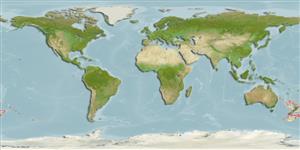Environment: milieu / climate zone / depth range / distribution range
Ecology
Marine; bathydemersal; depth range 800 - 1000 m (Ref. 51661). Deep-water
Southwest Pacific: New Zealand.
Size / Weight / Age
Maturity: Lm ? range ? - ? cm
Max length : 5.5 cm SL male/unsexed; (Ref. 92437); 9.5 cm SL (female)
Short description
Identification keys | Morphology | Morphometrics
Dorsal soft rays (total): 47 - 48; Anal soft rays: 40 - 43; Vertebrae: 53 - 54. Distinguished by the following characters: vertebrae 53-54 (10+43-44); pectoral fin rays 37-38; caudal 12 (1+5/5+1); radials 4 (3+1), 3 upper notched, with 3 inter-radial fenestrae; HL 27.3-30%, preA 41-45%, disk 6-6.7%SL; pleural ribs are well-developed, 2 pairs present, saber-like; single hypural plate; terminal mouth, sharp tricuspid teeth; mandibular symphyseal pores small, round, widely spaced; gill slit above pectoral base; peritoneum and stomach black, pyloric caeca pale (Ref. 90036).
Life cycle and mating behavior
Maturity | Reproduction | Spawning | Eggs | Fecundity | Larvae
Andriashev, A.P., 1998. A review of recent studies of Southern Ocean Liparidae (Teleostei: Scorpaeniformes). Cybium 22(3): 255-266. (Ref. 30823)
IUCN Red List Status (Ref. 130435: Version 2024-2)
Threat to humans
Harmless
Human uses
Fisheries: of no interest
Tools
Special reports
Download XML
Internet sources
Estimates based on models
Preferred temperature (Ref.
123201): 4.1 - 4.8, mean 4.5 °C (based on 5 cells).
Phylogenetic diversity index (Ref.
82804): PD
50 = 0.5000 [Uniqueness, from 0.5 = low to 2.0 = high].
Bayesian length-weight: a=0.00457 (0.00208 - 0.01002), b=3.17 (2.99 - 3.35), in cm total length, based on LWR estimates for this Genus-body shape (Ref.
93245).
Trophic level (Ref.
69278): 3.2 ±0.5 se; based on size and trophs of closest relatives
Resilience (Ref.
120179): High, minimum population doubling time less than 15 months (Preliminary K or Fecundity.).
Fishing Vulnerability (Ref.
59153): Low vulnerability (10 of 100).
